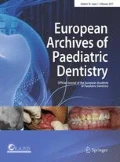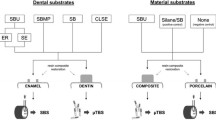Abstract
Aim
Evaluate the influence of enamel pre-treatment using Biosilicate, associated or not to other treatments; on the bond strength (BS) of pit-and-fissure sealant, with or without saliva contamination.
Methods
Ninety slices (4 mm × 4 mm) were obtained from 30 bovine incisors. Each slice was embedded in acrylic resin with their buccal surface exposed and polished to obtain a flat enamel surface. Half of them were contaminated with human saliva. All specimens were randomly divided into five groups (n = 9) according to the surface pre-treatment tested: acid etching (AE); AE + Biosilicate (B); AE + B + total-etch adhesive (Ad); Biosilicate; control (no treatment). Then, a 1 mm layer of sealant (Clinpro XT Varnish, 3M ESPE) was applied; and to provide support, a composite resin (Opallis, FGM) block was built up over it. Samples were thermocycled (500 cycles/5–55 °C) and sectioned obtaining sticks (1 × 1 × 10 mm) for microtensile BS testing (0.5 mm/min). Data were analysed with two-way ANOVA, Bonferroni test, p < 0.05. Failure patterns were evaluated using a stereomicroscope.
Results
There was no difference among contaminated and non-contaminated groups, and between non-contaminated groups (p > 0.05). When contaminated, AE + B + Ad Group showed the highest BS values, differing (p < 0.05) from B Group and Control; similar between them (p > 0.05). Cohesive fractures were found in AE + B + Ad Group, submitted or not to contamination.
Conclusions
Since a surface pre-treatment was used, whether Biosilicate was applied or not, the sealant/enamel BS was the same in saliva-contaminated or non-contaminated enamel.

Similar content being viewed by others
References
American Academy of Pediatric Dentistry. Guideline on restorative dentistry. Pediatr Dent. 2016;38:250–62.
Ashwin R, Arathi R. Comparative evaluation for microleakage between Fuji-VII glass ionomer cement and light-cured unfilled resin: a combined in vivo in vitro study. J Indian Soc Pedod Prev Dent. 2007;25(2):86–7.
Askarizadeh N, Norouzi N, Nemati S. The effect of bonding agents on the microleakage of sealant following contamination with saliva. J Indian Soc Pedod Prev Dent. 2008;26(2):64–6.
Barroso JM, Torres CP, Lessa FC, et al. Shear bond strength of pit-and-fissure sealants to saliva-contaminated and noncontaminated enamel. J Dent Child (Chic). 2005;72(3):95–9.
Beauchamp J, Caufield PW, Crall JJ, et al. Evidence-based clinical recommendations for the use of pit-and-fissure sealants: a report of the American Dental Association Council on Scientific Affairs. J Am Dent Assoc. 2008;139(3):257–68.
Beslot-Neveu A, Courson F, Ruse ND. Physico-chemical approach to pit and fissure sealant infiltration and spreading mechanisms. Pediatr Dent. 2012;34(3):57–61.
Borem LM, Feigal RJ. Reducing microleakage of sealants under salivary contamination: digital-image analysis evaluation. Quintessence Int. 1994;25(4):283–9.
Botton G, Morgental CS, Scherer MM, et al. Are self-etch adhesive systems effective in the retention of occlusal sealants? A systematic review and meta-analysis. Int J Paediatr Dent. 2016;26(6):402–11.
Chinelatti MA, Tirapelli C, Corona SAM, et al. Effect of a bioactive glass ceramic on the control of enamel and dentin erosion lesions. Braz Dent J. 2017;28(4):489–97.
Condò R, Cioffi A, Riccio A, et al. Sealants in dentistry: a systematic review of the literature. Oral Implantol (Rome). 2014;6(3):67–74.
Correr GM, Caldo-Teixeira AS, Alonso RC, et al. Effect of saliva contamination and re-etching time on the shear bond strength of a pit and fissure sealant. J Appl Oral Sci. 2004;12(3):200–4.
Crovace MC, Souza MT, Chinaglia CR, Peitl O, Zanotto ED. Biosilicate-A multipurpose, highly bioactive glass-ceramic. In vitro, in vivo and clinical trials. J Non Cryst Solids. 2016;432:90–110.
Ellis RW, Latta MA, Westerman GH. Effect of air abrasion and acid etching on sealant retention: an in vitro study. Pediatr Dent. 1999;21(6):316–9.
Eskandarian T, Baghi S, Alipoor A. Comparison of clinical success of applying a kind of fissure sealant on the lower permanent molar teeth in dry and wet conditions. J Dent (Shiraz). 2015;16(3):162–8.
Featherstone JD. Prevention and reversal of dental caries: role of low level fluoride. Community Dent Oral Epidemiol. 1999;27(1):31–40.
Hench LL. The story of Bioglass. J Mater Sci Mater Med. 2006;17(11):967–78.
Hench LL. An Introduction to Bioceramics. 2nd ed. London: Imperial College Press; 2013.
Jurić H. Current possibil ities in occlusal caries management. Acta Med Acad. 2013;42(2):216–22.
Khoroushi M, Karimi B. Saliva contaminated and re-etched all-in-one adhesive: influence on bond strength. J Dent Res. 2006;3(1):10–5.
Kidd EA. Microleakage: a review. J Dent. 1976;4(5):199–206.
Kim J, Hong S, Choi Y, Park S. The effect of saliva decontamination procedures on dentin bond strength after universal adhesive curing. Restor Dent Endod. 2015;40(4):299–305.
Manhart J, Huth KC, Chen HY, Hickel R. Influence of the pretreatment of occlusal pits and fissures on the retention of a fissure sealant. Am J Dent. 2004;17(1):12–8.
Moura J, Teixeira LN, Ravagnani C, et al. In vitro osteogenesis on a highly bioactive glass-ceramic (Biosilicate). J Biomed Mater Res A. 2007;82(3):545–57.
Naaman R, El-Housseiny AA, Alamoudi N. The use of pit and fissure sealants—a literature review. Dent J. 2017;5(4):1–19.
Narayana SS, Deepa VK, Ahamed S, et al. Remineralization efficiency of bioactive glass on artificially induced carious lesion an in-vitro study. J Indian Soc Pedod Prev Dent. 2014;32(1):19–25.
Pardi A, Sindhoreti MA, Pereira AC, Ambrosano GM, Meneghim C. In vitro evaluation of microleakage of different materials used as pit and fissure sealants. Braz Dent J. 2006;17(1):49–52.
Park JW, Lee KC. The influence of salivary contamination on shear bond strength of dentin adhesive systems. Oper Dent. 2004;29(4):437–42.
Pashley DH, Carvalho RM, Sano H, et al. The microtensile bond test: a review. J Adhes Dent. 1999;1(4):299–309.
Pashley DH, Tay FR, Breschi L, et al. State of the art etch-and-rinse adhesives. Dent Mater. 2011;27(1):1–16.
Peitl O, Zanotto ED, Hench LL. Highly bioactive P2O5–Na2O–CaO-SiO2 glass-ceramics. J Non-Cryst Solids. 2001;292:115–26.
Pinar A, Sepet E, Aren G, et al. Clinical performance of sealants with and without primer and bond. Quintessence Int. 2005;36(5):355–60.
Pires-de-Souza FCP, Marco FF, Casemiro LA, Panzeri H. Desensitizing bioactive agents improves bond strength of indirect resin-cemented restorations: preliminary results. J Appl Oral Sci. 2007;15(2):120–6.
Pires-de-Souza FCP, Silveira RE, Abuna G, et al. Morphology of sealant/enamel interface after surface treatment with bioactive glass. Microsc Res Tech. 2015;78(12):1062–8.
Prasad M, Mohamed S, Nayak K, Shetty SK, Talapaneni AK. Effect of moisture, saliva, and blood contamination on the shear bond strength of brackets bonded with a conventional bonding system and self-etched bonding system. J Nat Sci Biol Med. 2014;5(1):123–9.
Reis A, Loguercio AD. A 36-month clinical evaluation of ethanol/water and acetone-based etch-and-rinse adhesives in non-carious cervical lesions. Oper Dent. 2009;34(4):384–91.
Rosa CB, Cavalcanti AN, Fontes CM, Mathias P. Effect of salivary contamination at different steps of the bonding process on the microleakage around Class V restorations. Braz J Oral Sci. 2007;6(23):1445–9.
Schwendicke F, Jäger AM, Paris S, Hsu LY, Tu YK. Treating pit-and-fissure caries: a systematic review and network meta-analysis. J Dent Res. 2015;94(4):522–33.
Scotti N, Cavalli G, Gagliani M, Breschi L. New adhesives and bonding techniques. Why and when? Int J Esthet Dent. 2017;12(4):524–35.
Sen Tunc E, Bayrak S, Tuloglu N, Ertas E. Evaluation of microtensile bond strength of different fissure sealants to bovine enamel. Aust Dent J. 2012;57(1):79–84.
Sofan E, Sofan A, Palaia G, et al. Classification review of dental adhesive systems: from the IV generation to the universal type. Ann Stomatol (Roma). 2017;8(1):1–17.
Taha AA, Patel MP, Hill RG, Fleming PS. The effect of bioactive glasses on enamel remineralization: a systematic review. J Dent. 2017;67:9–17.
Tirapelli C, Panzeri H, Soares RG, Peitl O, Zanotto ED. A novel bioactive glass-ceramic for treating dentin hypersensitivity. Braz Oral Res. 2010;24(4):381–7.
Tirapelli C, Panzeri H, Lara EHG, et al. The effect of a novel crystallised bioactive glass-ceramic powder on dentine hypersensitivity: a long-term clinical study. J Oral Rehabil. 2011;38(4):253–62.
Townsend RD, Dunn WJ. The effect of saliva contamination enamel and dentine using a selfetching adhesive. J Am Dent Assoc. 2004;135(7):895–901.
Tulunoglu O, Bodur H, Uctasl M, Alacam A. The effect of bonding agents on the microleakage and bond strength of sealant in primary teeth. J Oral Rehabil. 1999;26(5):436–41.
Unal M, Hubbezoglu I, Zan R, Oznurhan F. The effect of Er: YAG laser and different surface conditioning procedures on microtensile bond strength of the fissure sealant containing amorphous calcium phosphate after artificial aging. Dent Mater J. 2014;33(1):21–6.
Van Meerbeek B, De Munck J, Yoshida Y, et al. Buonocore memorial lecture. Adhesion to enamel and dentin: current status and future challenges. Oper Dent. 2003;28(3):215–35.
Welbury R, Raadal M, Lygidakis N. EAPD guidelines for the use of pit and fissure sealants. Eur J Paediatr Dent. 2004;5(3):179–84.
Yang SY, Piao YZ, Kim SM, et al. Acid neutralizing, mechanical and physical properties of pit and fissure sealants containing melt-derived 45S5 bioactive glass. Dent Mater. 2013;29(12):1228–35.
Author information
Authors and Affiliations
Corresponding author
Ethics declarations
Conflict of interest
The authors declare that they have no conflict of interest.
Additional information
Publisher’s Note
Springer Nature remains neutral with regard to jurisdictional claims in published maps and institutional affiliations.
Rights and permissions
About this article
Cite this article
Silveira, R.E., Vivanco, R.G., de Morais, R.C. et al. Bioactive glass ceramic can improve the bond strength of sealant/enamel?. Eur Arch Paediatr Dent 20, 325–331 (2019). https://doi.org/10.1007/s40368-018-0409-x
Received:
Accepted:
Published:
Issue Date:
DOI: https://doi.org/10.1007/s40368-018-0409-x




